
Financial Information
For more information on the new Emerging Contaminants Remediation Surcharge, please click here or scroll down the page.
Budgets
Thurston PUD has two primary funds: Water and General.
Water Fund
The Water Fund revenue
sources are rate revenue and interest income. Rate revenue is primarily
comprised of the base rate and consumption charges for residential,
commercial and irrigation use. Thurston PUD serves approximately 10,100
families, businesses, schools, and parks in five (5) counties: Thurston,
Pierce, Grays Harbor, Lewis, and King.
Thurston PUD uses water fund revenues to operate
and maintain 271 water systems, administrative and field operations
buildings and staff related expenses.
Below is a table reflecting the revenue and expenses for the current period.
Revenue and Expense Report
July 2025 YTD
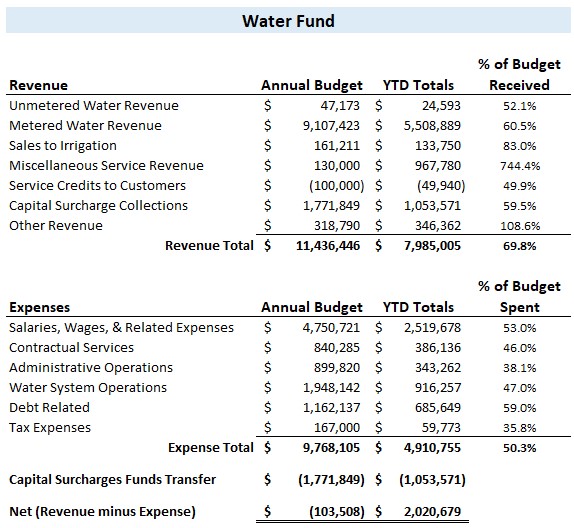
Below is a pie chart depicting the Water Fund Expenses for the current period.
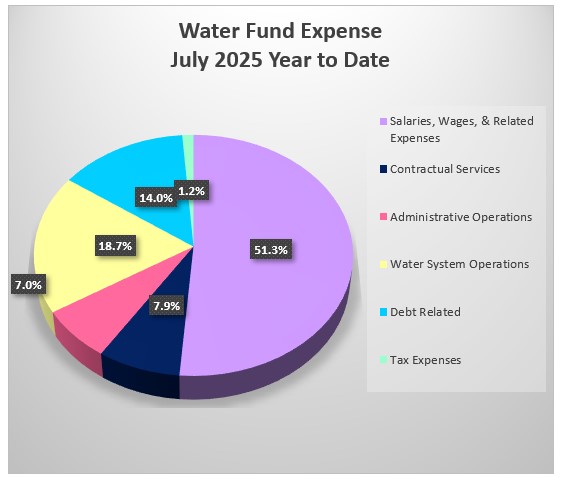
General Fund
The primary revenue source for the General Fund is property taxes
assessed for properties located in Thurston County. The 2025 property
tax rate for Thurston PUD is $0.005462476384 per $1,000 assessed value,
resulting in an estimated tax collection estimate of $346,387 in 2025.
At this tax rate, the owner of a $500,000 property will
pay $2.73 in property taxes to Thurston PUD in 2025. Also, the General
Fund yield interest on the cash balance reserves.
The primary use of the property taxes
Thurston PUD receives is to fund Board of Commissioners election costs,
salaries, and expenses. Additionally, the
General Fund pays a minimal allocation for operations and staff related
expenses.
Below is a table reflecting the revenue and expenses for the current period.
Revenue and Expense Report
July 2025 YTD
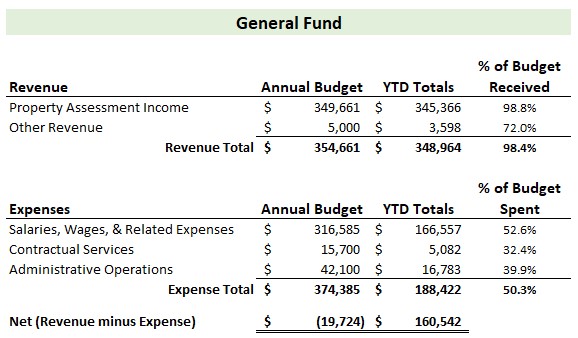
NEW! Emerging Contaminants Remediation Surcharge
In 2021, the Washington State Board of Health
adopted State Action Levels (SALs) for five newly regulated contaminates
called per- and polyfluoroalkyl substances (PFAS). PFAS are a large
family of human-made chemicals used to make stain resistant, water
resistant, and nonstick consumer products. A major source of PFAS in our
area is from firefighting foam used by the military, local fire
departments, and airports. PFAS in drinking water is a nationwide
problem.
Washington State develops SALs to protect the
health of drinking water consumers from contaminants that are not
federally regulated. The PFAS SALs are public health goals for lifetime
consumption of water, including by sensitive populations. When tap water
exceeds a SAL, the State Department of Health recommends that the water
system take action to bring the level below the SALs for long-term
drinking.
On April 10, 2024, the Environmental Protection
Agency (EPA) announced a final federal rule that newly regulates the
Maximum Contaminant Level (MCL) for six PFAS contaminants in drinking
water. The EPA PFAS Standards are expected to replace the Washington
State PFAS Standards when approved by the Washington State Board of
Health. Water systems must complete initial monitoring by 2027, inform
the public of results, and implement solutions to reduce PFAS if levels
exceed the limits by 2029.
The monitoring and remediation requirements for
PFAS set forth by DOH and EPA are specific to Group A water systems
only, which are defined as water systems with 15 or more water
connections. Group B water systems, which are defined as water system
with less than 15 water connections, are regulated by the local county
and currently do not have PFAS monitoring or remediation requirements.
Thurston PUD was an early implementor of PFAS
testing and identified the water systems that detect PFAS before testing
was done by most other municipalities. Largely because of this proactive
approach to identifying the presence of PFAS, Thurston PUD was approved
for funding with principal loan forgiveness through the Washington State
Drinking Water State Revolving Fund to install treatment systems to
remove PFAS from the drinking water at water systems above EPA’s MCL.
The customers on these water systems have been notified by letter of the
detected PFAS and our plan to install treatment before the required date
of 2029.
In 2025, Assistant General Manager, Julie Parker successfully entered into PFAS cost recovery court cases against national PFAS polluters. As of October 22, 2025, the PUD is approved for an allocation of settlement funds from 3M, estimated at $1,121,660.35, with disbursements from 2025 to 2033. To date, the PUD has received $530,381.22 of the approved settlement funds. As of October 15, 2025, the PUD is approved for an allocation of settlement funds from DuPont, estimated at $116,208.05, with disbursements from 2025 to 2033. To date, the PUD has received $91,636.15 fo the approved settlement funds. The Board may use these monies to further pursue financial recovery for ongoing and future PFAS costs from the polluters. All claim settlement funds received will be used to pay for PFAS related expenses only.
Although the PUD has submitted claims to the
polluters to get them to pay for all pollution costs; so far, the
one-time claim settlements will not be enough to cover the projected
ongoing PFAS expenses. The PUD must plan and budget for the annual PFAS
O&M and Media Replacement costs, averaging $173,524. The annual cost to
cover these expenses over 20 years is $1.78 per month per Group A water
system customer.
Starting, January 1, 2026, all Group A water
system customers will be charged the new EPA/WA
State Emerging Contaminants Remediation Surcharge of $1.78. The
surcharge collections will be kept in the EPA/WA State Emerging
Contaminants Remediation Fund separate from the other District funds.
The surcharges collected will be used only to pay for PFAS expenses. If
polluters can be held accountable and sufficient funding is secured, the
surcharge monies would be used to either lower rates or refunded to
ratepayers.
The new monthly Emerging Contaminants Remediation
Surcharge of $1.78, billed to Group A water system customers only, is
necessary to ensure funding is available now and in the future for PFAS
on-going operations, maintenance, and media replacement costs.
If you do not know if you are on a Group A or Group B water system, you can contact Customer Service toll-free at (866) 357-8783 or by email at PUDCustomerService@thurstonpud.org to request this information.
The table below depicts the PFAS
Remediation fund balance cannot pay for the PFAS general operations and
maintenance expenses and media replacement costs when using only the
one-time money received from claim settlements.

This graph below shows the estimated costs
for general Operations and Maintenance (O&M) expenses and media
replacement costs, the one-time money from claim settlements and the new
monthly EPA/WA State Emerging Contaminants Remediation Surcharge of
$1.78 billed to all Group A water system customers (approximately 9,100
customers).
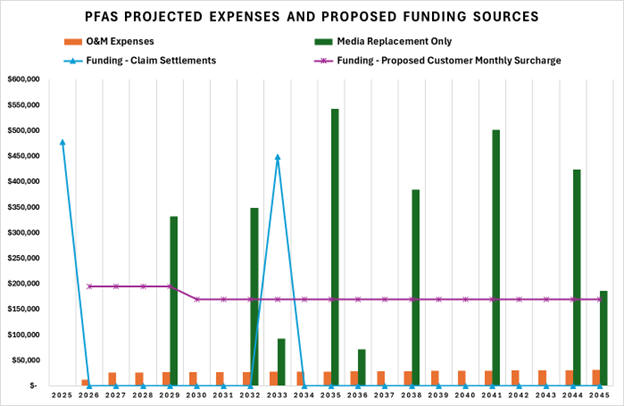
The table below provides the
EPA/WA State Emerging Contaminants
Remediation fund balance on an annual basis for the general O&M expenses
and media replacement costs, and the annual fund balance if claim
settlements only paid for the expenses and if claim settlements and the
monthly new EPA/WA State Emerging Contaminants Remediation Surcharge
paid for the expenses. In column F, if the claim settlements only paid
for the PFAS expenses, the fund balance would not be able to pay for the
expenses in year 2032. However, in column G, if claim settlements and
the monthly new EPA/WA State Emerging Contaminants Remediation Surcharge
paid for the PFAS expenses there would be money to pay for the annual
expenses. Please note, this table does not include the estimated cost
for the treatment plant replacements. In 2027, when the treatment plants
are installed, District staff will review the treatment plant
replacements estimated costs and reassess the monthly surcharged needed
to pay for all PFAS expenses.
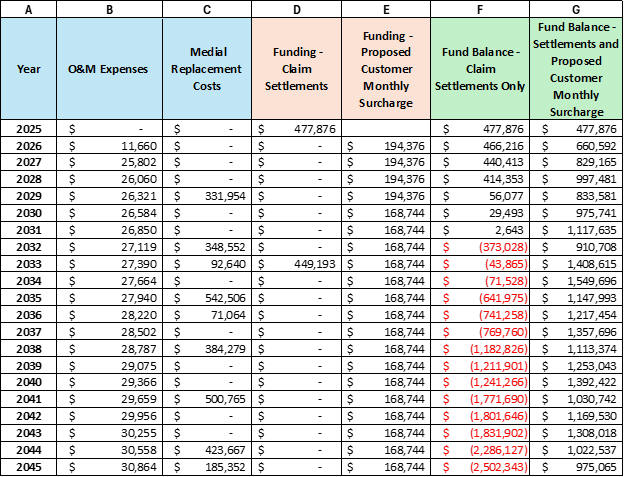
Audit Reports - WA State Auditor's Office